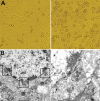Emerging Sand Fly-Borne Phlebovirus in China
- PMID: 32946723
- PMCID: PMC7510709
- DOI: 10.3201/eid2610.191374
Emerging Sand Fly-Borne Phlebovirus in China
Abstract
We isolated 17 viral strains capable of causing cytopathic effects in mammalian cells and death in neonatal mice from sand flies in China. Phylogenetic analysis showed that these strains belonged to the genus Phlebovirus. These findings highlight the need to control this potentially emerging virus to help safeguard public health.
Keywords: Bunyavirales; Corfu virus; PCR; Phlebotomus chinensis; Toros virus; Wuxiang virus; amino acid sequences; nucleotide sequences; phleboviruses; polymerase chain reaction; sand flies; sand fly–borne phlebovirus; vector-borne infections; viruses.
Figures


References
-
- International Committee on Taxonomy of Viruses. Virus taxonomy: 2018b release. 2018 [cited 2019 Jun]. https://talk.ictvonline.org/taxonomy
-
- Depaquit J, Grandadam M, Fouque F, Andry PE, Peyrefitte C. Arthropod-borne viruses transmitted by phlebotomine sandflies in Europe: a review. Euro Surveill. 2010;15:19507. - PubMed
Publication types
MeSH terms
LinkOut - more resources
Full Text Sources

